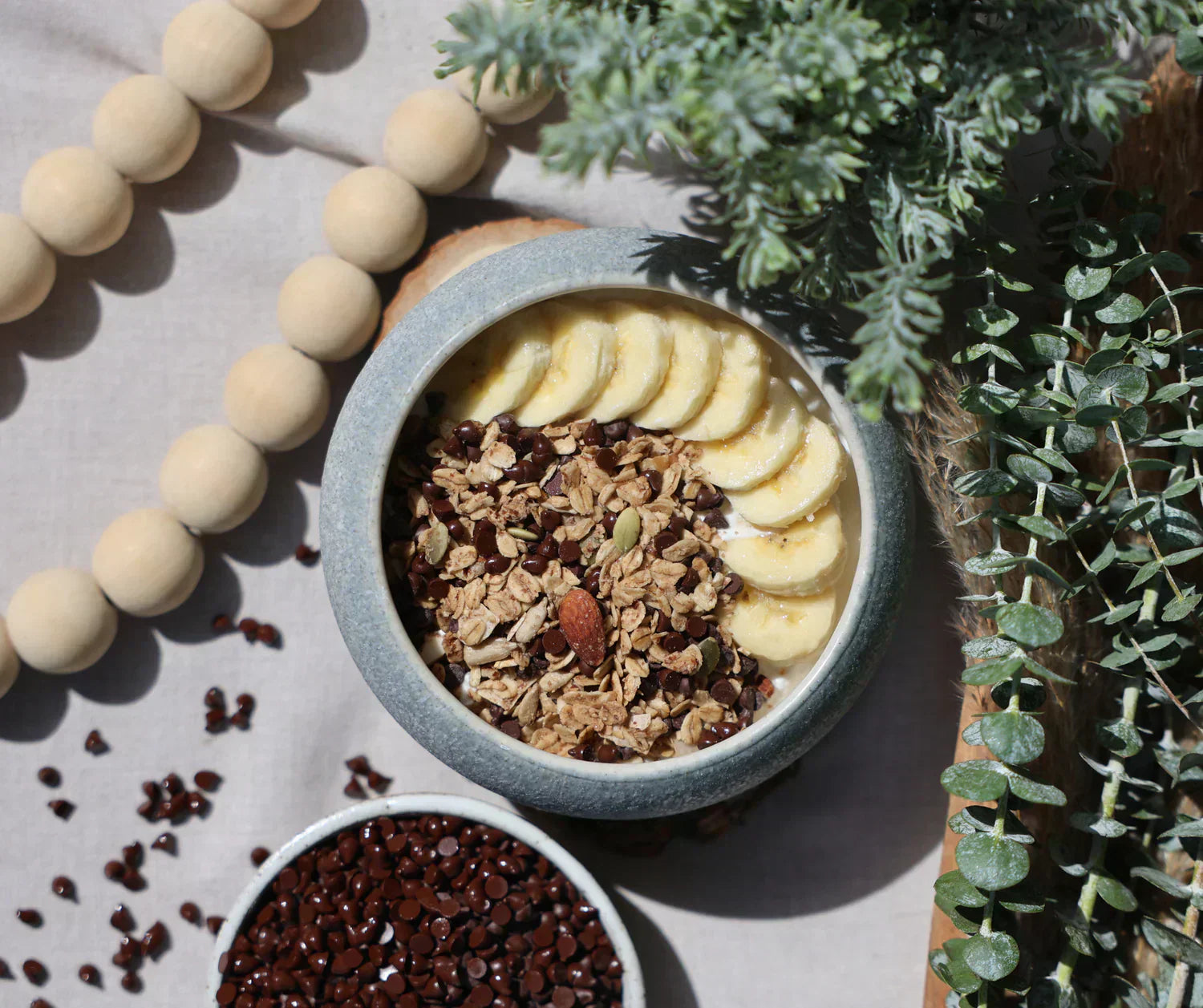
The Complete Guide to Finding Low-Sugar, Gluten-Free Options That Actually Taste Good
"Is granola healthy?" If you've ever stood in the cereal aisle staring at bags claiming to be "natural," "wholesome," or "nutritious," you've probably asked yourself this question. And you're right to be skeptical. Here's the uncomfortable truth: most granola is closer to dessert than a healthy breakfast.
The average granola contains 7-10g of added sugar per serving, 100-200mg of sodium, and oils extracted using chemical solvents like hexane. Many brands use tiny serving sizes (¼ cup) to hide their true nutritional profile and manipulate how healthy they appear. And don't even get us started on "natural flavors"—lab-created chemical compounds masquerading as real ingredients.
In this comprehensive guide, we'll answer the burning question "is granola healthy?" once and for all. You'll learn exactly what makes granola healthy (or unhealthy), how to spot truly nutritious options, and why gluten-free, low-sugar granola made with minimally processed ingredients represents the gold standard for your morning bowl.
By the end, you'll know exactly what to look for—and we'll show you why Brekky Mix was specifically designed to solve every problem with conventional granola.
Is Granola Healthy? The Short Answer
The Verdict: It Depends Entirely on the Brand
Quick Answer: Granola CAN be healthy, but most brands fail to meet basic nutrition standards. The difference between healthy granola and "breakfast candy" comes down to three critical factors:
- Added sugar content (should be ≤5g per serving, most contain 7-12g)
- Sodium levels (ideally 0mg, most contain 50-270mg)
- Ingredient quality (whole foods with minimal processing vs. lab-created ingredients and chemically extracted oils)
The Granola Paradox
Granola was originally created as a health food in the late 1800s, designed to provide wholesome nutrition through whole grains, nuts, and seeds. But somewhere along the way, it was corrupted by four major industry trends:
Sugar creep: Brands have gradually increased sugar content year over year, competing on sweetness rather than nutrition. What started as a lightly sweetened whole-grain breakfast has morphed into a sugar delivery system.
Cheap oil substitution: Heart-healthy oils like olive oil have been replaced by heavily processed seed oils extracted using chemical solvents, or oils high in saturated fat. The reason? Cost savings and consumer unfamiliarity with using olive oil in breakfast foods.
Hidden sodium inflation: Salt is added to enhance flavor and extend shelf life, turning what should be a heart-healthy breakfast into a sodium bomb that starts your day with elevated blood pressure.
Serving size manipulation: Most brands use ¼ cup (30g) servings that leave you hungry within an hour, while hiding the true sugar and sodium content. When you eat a realistic portion (½ cup), you're consuming double the sugar and sodium listed on the label.
What This Guide Covers
This comprehensive article is divided into seven sections that will transform you from confused consumer to informed granola expert:
- The truth about granola nutrition - What makes it healthy or unhealthy
- Gluten-free granola explained - When it matters and how to choose quality
- Finding truly low-sugar options - Without sacrificing taste
- How to identify the healthiest granola - Your shopping checklist
- Why Brekky Mix is different - Solving the granola problem
- Easy healthy breakfast ideas - Creative ways to enjoy granola
- The final verdict - Your action plan
For our complete analysis of 40+ granola brands, including detailed nutrition breakdowns and side-by-side comparisons, see our Healthiest Granola 2025 Guide.
The Truth About Granola Nutrition
What Makes Granola Unhealthy? The Three Major Problems
Problem #1: The Sugar Scandal - "Sugar Creep" and "Sugar Stacking"
The sugar situation in granola has spiraled out of control through two insidious industry practices:
"Sugar Creep": How granola brands have gradually increased sugar content year over year to compete on sweetness rather than nutrition. What was once 4-5g of added sugar per serving in the 1990s has crept up to 7-12g today. Consumers have been gradually conditioned to expect increasingly sweeter granola, and brands have obliged.
"Sugar Stacking" Trick: Here's where it gets sneaky. Brands split sugar across multiple ingredients so no single sugar source appears high on the ingredient list. Instead of listing sugar as the second (or even first) ingredient, they'll use relatively smaller amounts of five different sweeteners that each appear lower down the ingredient list—making the product look healthier than it actually is.
Watch for these hidden sugars:
- Tapioca syrup (highly processed, pure glucose)
- Brown rice syrup (sounds healthy, still 100% sugar)
- Barley malt syrup (maltose sugar with minimal nutrients)
- Agave nectar (higher fructose content than high-fructose corn syrup)
- Fruit juice concentrate (stripped of fiber, just concentrated sugar)
- Plus the obvious: cane sugar, honey, maple syrup
When you add up all these stacked sugar sources, you're often consuming 10-12g of added sugar—as much as a glazed donut. The result? A blood sugar spike followed by the infamous mid-morning crash that has you reaching for more sugar by 10 AM.
The Data: Our analysis of 40+ premium granola brands revealed that 75% exceed the expert-recommended 5g limit for added sugar at breakfast. The average sits at 7.5g, with some "healthy" brands containing up to 12g per serving.
Problem #2: The Sodium Problem Most People Miss
While everyone focuses on sugar, sodium quietly sabotages your health—especially problematic when consumed first thing in the morning.
Why it matters: Consuming sodium at breakfast sets the tone for your blood pressure for the entire day. Starting with a high-sodium meal can cause water retention and elevated blood pressure that may persist for hours, placing unnecessary stress on your cardiovascular system.
Industry Reality: Only 7 out of 42 analyzed brands achieve zero sodium. The rest contain anywhere from 50-270mg per serving—that's up to 11% of your daily sodium limit before you've even left the house.
Common amounts in "healthy" granolas:
- Purely Elizabeth varieties: 127-203mg
- Bob's Red Mill: 130-180mg
- Nature's Path: 110mg
- Some brands: Up to 270mg (more than a serving of potato chips!)
The excuse: "Sodium enhances flavor." Translation: We're using salt to mask cheap, bland ingredients instead of investing in premium, whole foods that taste good naturally.
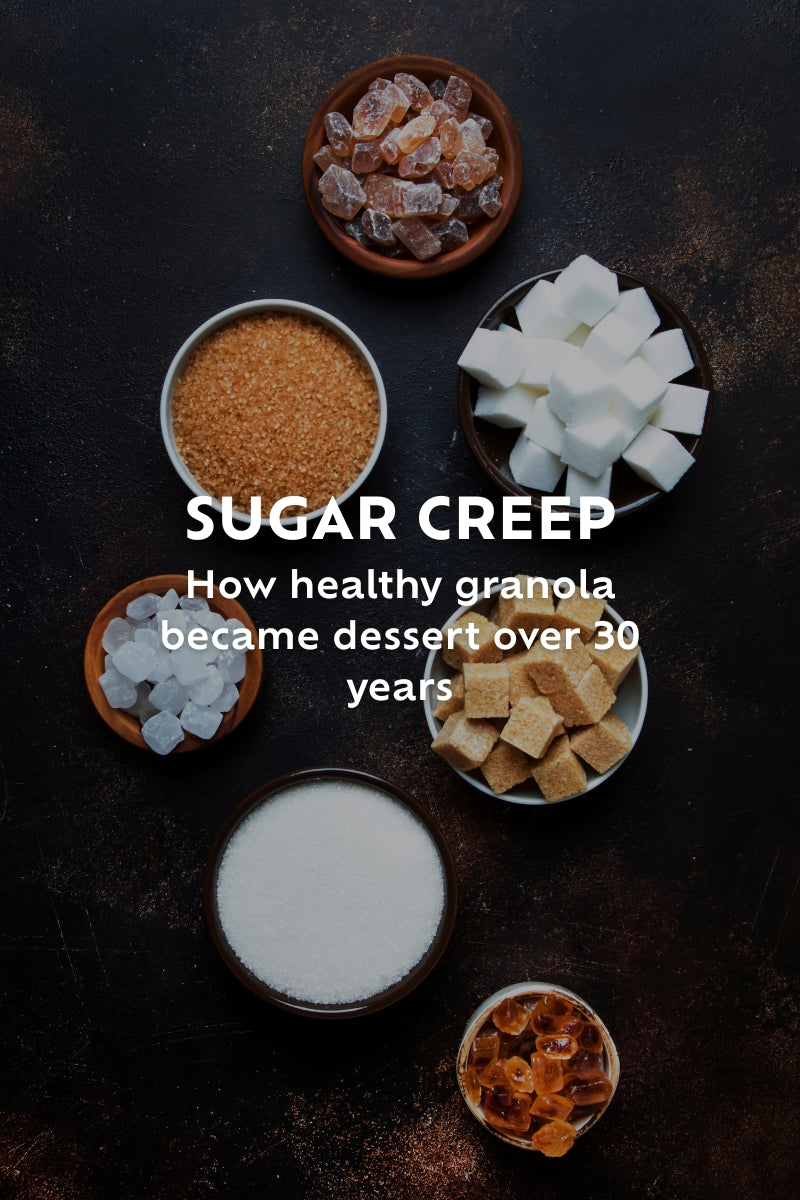

Problem #3: The Ultra-Processed Oil Problem
This is perhaps the most overlooked issue in granola, but it matters tremendously for your health.
85% of brands use: Coconut oil, canola oil, or seed oils (sunflower, soybean, safflower)
The issue with seed oils: These are highly processed using chemical solvents, such as hexane (a petroleum derivative), for extraction. The industrial refining process involves:
- Chemical solvent extraction
- High-heat processing (which can oxidize the oils)
- Deodorizing to remove the unpleasant smell
- Bleaching to improve appearance
This is about as far from "whole food" as you can get. Beyond the processing concerns, there is an ongoing debate in the nutrition community about the high omega-6 content of seed oils and their potential inflammatory effects, although the science remains mixed. What's not debatable: most consumers seeking healthy granola want minimally processed, real food ingredients, not oils extracted using industrial chemicals.
Coconut oil reality: While coconut oil isn't processed with chemical solvents like seed oils, it's significantly higher in saturated fat than heart-healthy alternatives. While not as problematic as chemically extracted oils, it's not the optimal choice for cardiovascular health.
The better choice: Olive oil stands alone as a minimally processed, heart-healthy fat with:
- Monounsaturated fats (proven cardiovascular benefits)
- Natural antioxidants (polyphenols)
- Mediterranean diet association (one of the most studied, healthiest dietary patterns)
- Simple, mechanical extraction (cold-pressed, no chemicals)
Why brands don't use it: Cost and American consumer unfamiliarity. Olive oil costs significantly more than seed oils, and many Americans don't associate olive oil with breakfast foods (despite its prominence in Mediterranean breakfasts for centuries).
The Processing Problem: Most consumers want whole foods and minimally processed ingredients in their "healthy" granola. Chemical solvent extraction doesn't align with that desire—yet most granola relies on it.
What Makes Granola Healthy? The Science-Backed Standards
Now that you know what to avoid, here's what to look for. These standards are based on nutritional science and expert recommendations from registered dietitians:
✓ Added Sugar: ≤5g per serving (3g or less is exceptional)
✓ Sodium: 0-50mg per serving (0mg is ideal for heart health)
✓ Protein: ≥7g for satiety and sustained energy
✓ Fiber: ≥5g for digestive health and blood sugar control
✓ Healthy Fats: Olive oil, whole nuts, whole seeds (not chemically extracted seed oils or excessive saturated fat)
✓ Serving Size: Honest portions (½ cup minimum for realistic satisfaction)
✓ Ingredients: Real, whole foods (not lab-created "natural flavors" or protein isolates)
A truly healthy granola should check ALL these boxes—not just some of them. Many brands excel in one area while failing miserably in others.
The Ingredient Red Flags to Avoid
When you flip that granola bag over and scan the ingredient list, watch for these warning signs:
"Natural flavors": These are lab-created flavor compounds synthesized to mimic real ingredients. Despite the word "natural" (which simply means derived from a natural source at some point), these are chemical compounds created in laboratories. If a brand uses real vanilla, they'll say "vanilla powder" or "vanilla bean." If they use "natural vanilla flavor," that's a red flag.
"Sugar stacking": Multiple sugar sources scattered throughout the ingredient list:
- Tapioca syrup + brown rice syrup + barley malt syrup = sugar overload
- This trick keeps individual sugars lower on the list while total sugar remains high
- Watch for: tapioca syrup, brown rice syrup, fruit juice concentrate, agave nectar, barley malt
Chemically extracted seed oils: Sunflower oil, canola oil, soybean oil, all processed with hexane. These represent the opposite of whole food nutrition.
Protein isolates: Lab-created protein powders (whey protein isolate, pea protein isolate) instead of whole food protein from nuts and seeds. While these boost protein numbers, they're ultra-processed ingredients, not real food.
Tiny serving sizes: ¼ cup servings are marketing manipulation. Nobody eats just ¼ cup of granola and feels satisfied. This is purely to make the nutrition facts look better than they are.
High sodium in a "healthy" product: Any granola with over 100mg of sodium per serving is questionable. There's simply no reason for that much salt in a breakfast cereal, except to enhance flavor and cover up inferior ingredients.
Learn more about the difference between natural and added sugars in our guide to Understanding Added Sugar.
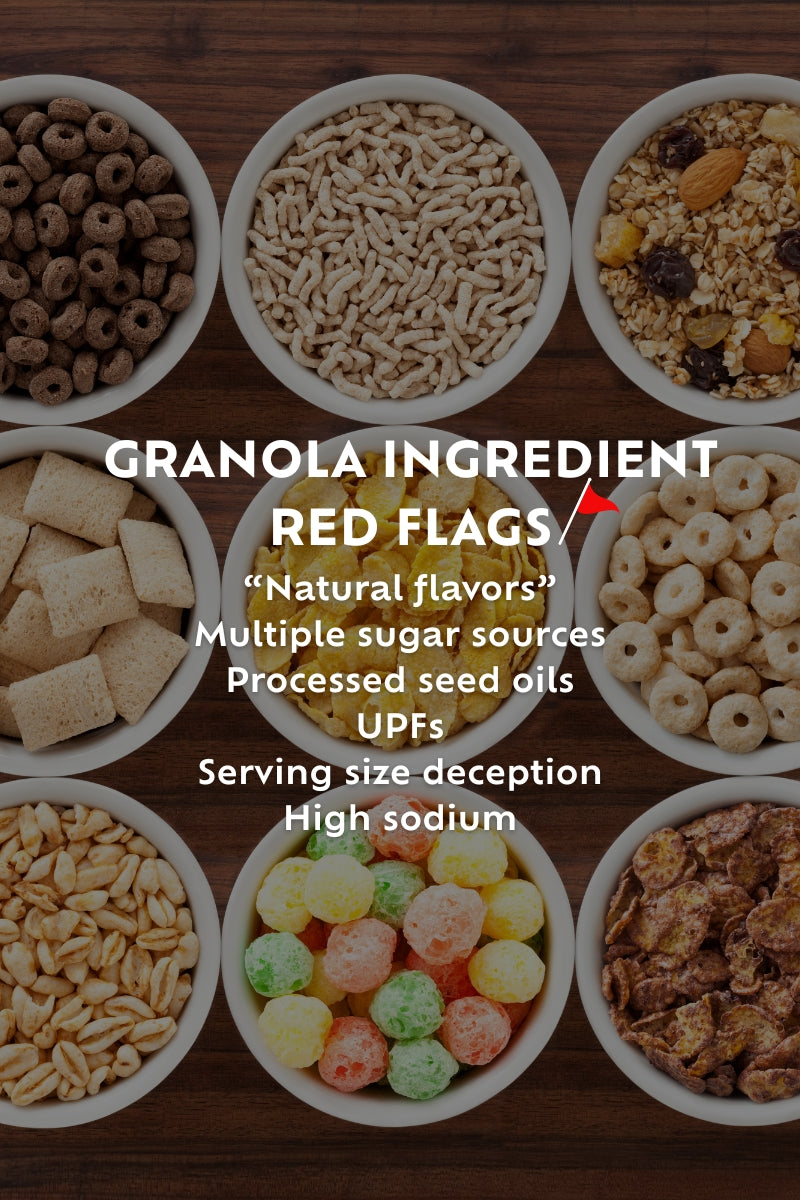
Why Gluten-Free Granola Matters (Even If You Don't Have Celiac Disease)
For People with Celiac Disease or Gluten Sensitivity:
For the roughly 1% of the population with celiac disease and 6% with non-celiac gluten sensitivity, gluten-free granola isn't a choice—it's a medical necessity. Even trace amounts of gluten can trigger serious health consequences including:
- Intestinal damage and inflammation
- Nutrient malabsorption
- Chronic digestive issues
- Autoimmune responses
The challenge? Cross-contamination is rampant in conventional oat processing, making most "regular" granola unsafe even though oats themselves are naturally gluten-free.
For Everyone Else:
Even if you don't have celiac disease or diagnosed gluten sensitivity, gluten-free granola often indicates higher quality standards:
- Better ingredient sourcing: Products using certified gluten-free oats typically invest in premium ingredient sourcing across the board
- Reduced pesticide exposure: Gluten-free and organic often go hand-in-hand, reducing your exposure to agricultural chemicals
- Cleaner formulation: Brands that use certified gluten-free ingredients tend to be more careful about overall ingredient quality
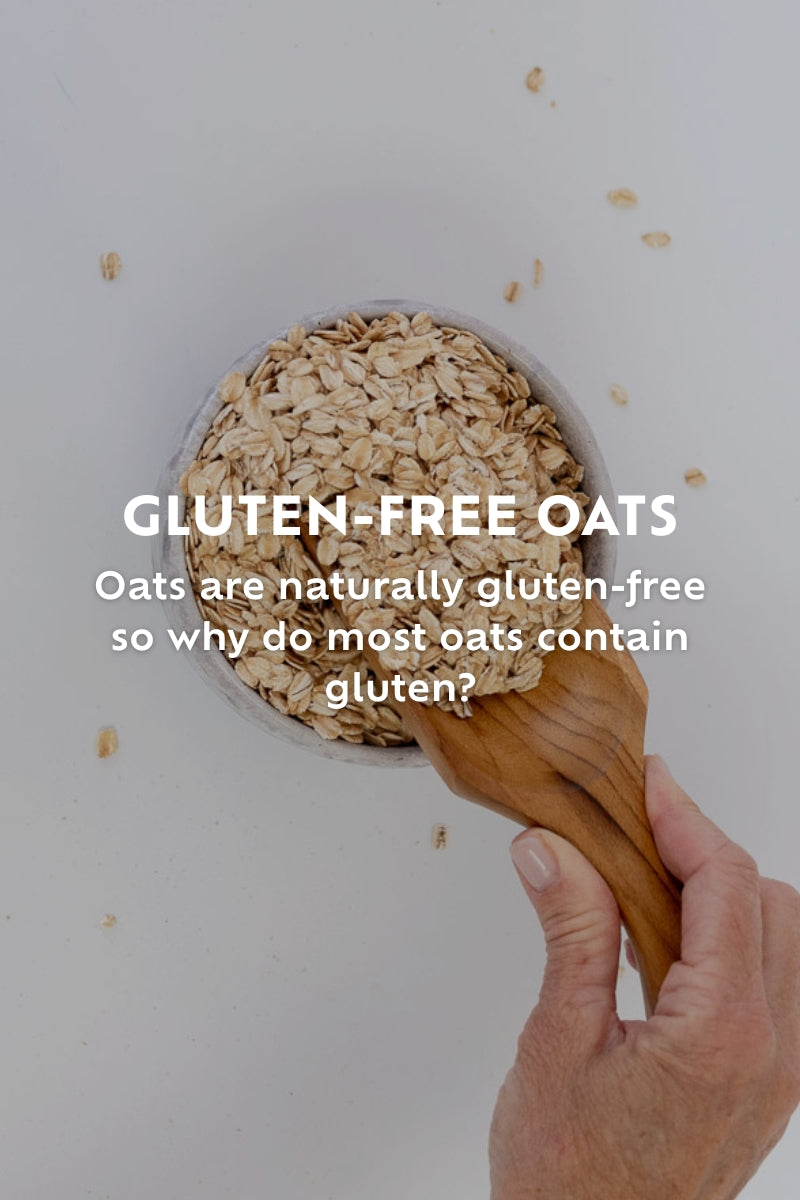
Understanding Gluten-Free Oats: What Makes Them Different?
Here's the confusing truth: Oats are naturally gluten-free, but most oats contain gluten. How is this possible?
The Cross-Contamination Problem:
Regular oats become contaminated with gluten through the entire agricultural and processing chain:
- Field Contamination: Oats are often grown in fields that previously grew wheat, barley, or rye. Volunteer grains from previous crops grow alongside the oats.
- Equipment Sharing: Oats are harvested using the same combines and equipment used for wheat and other gluten-containing grains.
- Transportation: Grain trucks and railcars transport multiple types of grain, which can lead to cross-contamination.
- Processing Facilities: Most oat processing facilities also handle wheat, barley, and rye, contaminating the oats during milling and packaging.
The result? "Regular" oats typically contain 10-300+ parts per million (ppm) of gluten, well above the 20 ppm threshold that's considered safe for those with celiac disease.
What Makes Oats Truly "Gluten-Free":
Certified gluten-free oats require a completely separate supply chain:
- Dedicated fields: Never planted with wheat, barley, or rye (strict crop rotation protocols)
- Dedicated equipment: Separate harvesters, trucks, and processing machinery
- Rigorous testing: Must test below 20 ppm gluten to earn certification
- Third-party verification: Independent certification bodies verify GF status throughout the process
Why This Costs Significantly More:
Understanding the cost differential helps justify the premium price:
- Specialized farming practices and careful crop rotation
- Investment in dedicated processing facilities
- Continuous testing at multiple stages
- Third-party certification fees
- Smaller production volumes (economies of scale don't apply)
This isn't arbitrary markup—it's the true cost of ensuring safety and purity.
The Organic + Gluten-Free Advantage
Why Organic Matters Specifically for Oats:
Many conventional oats are sprayed with glyphosate (Roundup) as a drying agent shortly before harvest. This common agricultural practice:
- Increases glyphosate residue in your breakfast cereal
- Has raised serious health concerns (classified as "probably carcinogenic to humans" by the World Health Organization's International Agency for Research on Cancer)
- Is banned in many European countries due to these health concerns
- Is completely unnecessary with proper harvesting techniques
Testing has repeatedly found concerning levels of glyphosate in popular conventional oat products. For consumers seeking "healthy" granola, starting your day with pesticide residue defeats the entire purpose.
Organic Certification Eliminates:
- Glyphosate exposure (prohibited in organic farming)
- Synthetic pesticides and herbicides
- GMO contamination
- Chemical fertilizers
- Growth regulators and desiccants
The Premium Choice: Organic oats made from certified gluten-free oats represent the highest quality standard for health-conscious consumers who want:
- Zero gluten cross-contamination (safe for celiac)
- Zero pesticide residues (especially glyphosate)
- Whole food nutrition from clean sources
- Complete peace of mind
The Gluten-Free Granola Problem: Not All Are Created Equal
Here's where many consumers get tripped up: Just because it's gluten-free doesn't mean it's healthy.
Many gluten-free granolas actually have worse nutrition than conventional options:
Common Problems:
- Extra sugar compensation: Brands add more sugar to improve texture and mask any flavor differences from gluten-free processing
- More binding agents: Additional processing aids and gums to improve texture
- Higher prices with similar nutrition: Charging a premium while delivering the same sugar, sodium, and oil problems as regular granola
- "Natural flavors" reliance: Using lab-created flavors instead of premium real ingredients
The Gluten-Free Tax Without the Benefits: Some brands charge 30-50% more for gluten-free versions that are nutritionally identical (or worse) than their regular products.
What to Look For in Gluten-Free Granola
Your Quality Checklist:
- Certified gluten-free oats as an ingredient: Look for brands that use oats with gluten-free certification, whether or not the final product carries certification. This ensures the oats themselves meet rigorous testing standards (below 20 ppm gluten).
- Organic ingredients: Whether through product certification or ingredient sourcing, look for organic oats to ensure no glyphosate or synthetic pesticides were used, providing an additional layer of health protection.
- Complete nutrition profile: Don't sacrifice protein, fiber, or healthy fats just to get gluten-free. Demand both.
- Whole food ingredients: Real nuts, seeds, and spices—not protein isolates, "natural flavors," or other lab-created ingredients.
- Transparent ingredient sourcing: Premium brands will tell you where their oats come from, how they're processed, and what certifications their ingredients carry—even if the final product isn't certified.
The Best Gluten-Free Granola: What Sets Premium Apart
Superior Oat Quality:
- Organic AND certified gluten-free (double protection)
- Tested for glyphosate contamination beyond just gluten
- Carefully sourced with traceable supply chains
- Never sprayed with desiccating chemicals
Complete Nutrition Without Compromise:
- High protein from whole nuts and seeds (7-8g minimum, not protein isolates)
- Rich fiber from whole grains (5-6g for digestive health and blood sugar management)
- Balanced macros from real food sources (not engineered in a lab)
Minimally Processed, Whole Food Ingredients:
- Real Ceylon cinnamon (not "natural cinnamon flavor")
- Madagascar vanilla powder from actual vanilla beans (not extract with "natural flavors")
- Pure maple syrup in small amounts (not tapioca syrup or brown rice syrup)
- Whole food protein from nuts and seeds (not protein isolates)
- Minimally processed olive oil (not chemically extracted seed oils)
A Note About Certification: Some premium granolas use certified gluten-free ingredients without being certified gluten-free products themselves. This is common for small-batch producers where the full product certification process is cost-prohibitive, but the ingredients meet the same rigorous standards. These products use certified gluten-free oats and are made in dedicated gluten-free environments, providing safety for most consumers with gluten concerns.
At Merricks Kitchen, we use only organic, gluten-free oats made from certified gluten-free oats that are rigorously tested—because your health deserves premium ingredients without compromise.
Gluten-Free Granola: Understanding the Price
Why Quality Costs More (And Why It's Worth It):
When you see premium granola priced higher than conventional options, here's what you're actually paying for:
- Certified gluten-free oats: These cost significantly more due to dedicated farming, equipment, and testing throughout the supply chain
- Dedicated gluten-free facilities and equipment: Significant capital investment to ensure no cross-contamination
- Premium ingredient sourcing: Higher-quality nuts, seeds, and oils that meet stricter standards
- Organic and Non-GMO ingredients: When brands use organic oats and other certified organic and non-GMO ingredients, costs increase substantially
- Smaller production volumes: Small-batch producers can't achieve the same economies of scale as mass-market brands
True Value Calculation:
Don't just compare price per ounce. Consider:
- Nutrition density: More protein and fiber per serving means better satiety and fewer total calories needed
- Ingredient quality: Certified organic gluten-free oats (never sprayed with glyphosate as a desiccant) vs. conventional oats with pesticide residue
- Health investment: The cost of prevention through clean food vs. managing health issues down the line
- Satisfaction factor: Honest serving sizes and quality ingredients that actually keep you full
Our Brekky Mix Trio offers all three varieties made with certified gluten-free oats in a dedicated gluten-free facility, so you can find your favorite while saving on your first order.
Low Sugar Granola That Actually Tastes Good
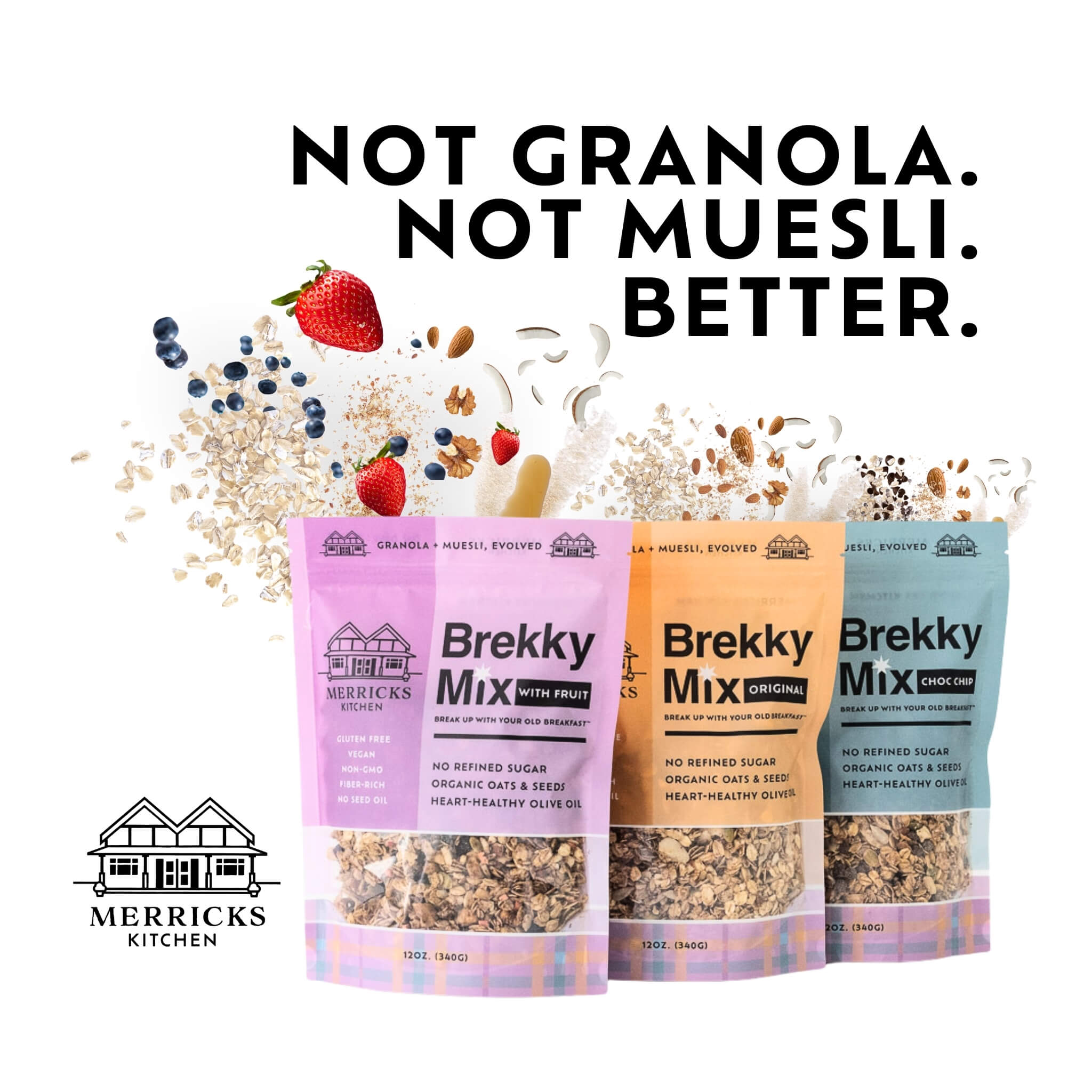
The Low-Sugar Challenge: Why Most Brands Fail
Here's the fundamental problem facing every granola manufacturer: consumers want healthy granola with minimal sugar, but most people have been conditioned to expect sweetness in their breakfast.
The Granola Dilemma:
- Traditional granola: 7-12g added sugar → Great taste, not great for blood sugar and health
- "Low sugar" or zero sugar granola: 0-2g added sugar → Numbers look good, but often tastes like cardboard or relies on artificial sweeteners
- The missing middle: Where's the granola with great nutrition AND great taste?
This is why most consumers end up compromising. They either sacrifice their health for taste, or they force down bland granola while dreaming of the sweet stuff.
How Much Sugar Should Healthy Granola Have?
Let's establish science-based standards rather than marketing claims:
Expert Recommendations:
- American Heart Association: Limit total added sugars to no more than 25g per day for women (6 teaspoons) and 38g per day for men (9 teaspoons)
- Registered Dietitians: When it comes to individual foods like granola, many recommend keeping added sugar to 5g or less per serving for optimal blood sugar management
- Metabolic Health Experts: Lower is better for blood sugar control, but sustainability matters (people need to actually enjoy eating it)
Reality Check on Industry Standards:
- Most "healthy" granolas: 7-10g added sugar
- Some popular brands: Up to 12g (as much as a frosted donut)
- Average across 40+ brands we analyzed: 7.5g
What Counts as "Low Sugar Granola"?
- Exceptional: 0-3g added sugar
- Good: 3-5g added sugar
- Questionable: 5-7g added sugar
- Too High: 7g+ (this is where most "healthy" brands land)
The Secret to Low Sugar Granola That Tastes Amazing
Here's what most brands don't understand: achieving low sugar with great taste requires premium whole food ingredients, not cheap fillers or artificial enhancement.
The Failed Approaches:
Most brands take one of two paths:
- Add lots of sugar → Tastes great, spikes blood sugar, defeats the health purpose
- Add no sugar or use artificial sweeteners → Healthy numbers on paper, but terrible taste or artificial aftertaste that trains your palate to expect intense sweetness
The Third Way: Whole Food Ingredient Innovation
How premium low-sugar granola achieves minimal added sugar (2-3g) while tasting incredible:
1. Ceylon Cinnamon:
- Provides natural sweetness enhancement without any sugar
- Contains compounds that actually help regulate blood sugar
- Most brands use harsh cassia cinnamon (cheaper, harsher flavor) or "natural cinnamon flavor" (lab-created)
- Ceylon cinnamon (true cinnamon) offers warm, sweet complexity that makes less sugar taste like more
2. Madagascar Vanilla Powder:
- Made from real vanilla beans ground into powder
- Rich, authentic vanilla provides deep flavor complexity
- Contrast this with "natural vanilla flavor"—lab-created compounds that provide one-dimensional sweetness
- Real vanilla from whole beans delivers hundreds of flavor compounds that satisfy in ways sugar never can
3. Pure Maple Syrup Used Sparingly:
- Complex natural sweetness with minerals (manganese, zinc)
- Used in small amounts because premium ingredients enhance its effectiveness
- Most brands use cheap sweeteners in large amounts; premium brands use quality sweeteners in small amounts
4. Whole Food Ingredient Synergy:
- When every ingredient is premium quality, they enhance each other's natural flavors
- Ceylon cinnamon + Madagascar vanilla + pure maple syrup create flavor complexity
- No need for excessive sugar when real ingredients provide natural satisfaction
- This is food science through culinary tradition, not laboratory manipulation
The Result: Minimal added sugar (2-3g per serving) with taste that rivals or exceeds high-sugar competitors—achieved through ingredient quality and culinary wisdom rather than laboratory tricks.
Low Sugar Doesn't Mean Low Taste: The Science of Whole Foods
Understanding why this approach works helps you identify truly premium options:
Taste Bud Adaptation (2-3 Week Reset):
- Your palate adapts to less sugar in 2-3 weeks
- The more whole foods you eat, the sweeter natural foods taste
- People who regularly eat 10g+ sugar at breakfast find 3g unsatisfying at first
- After 2-3 weeks, their taste buds reset and 10g tastes sickeningly sweet
Natural Sweetness Compounds:
- Real cinnamon and vanilla contain naturally sweet-tasting compounds
- These satisfy sweetness receptors without spiking blood sugar
- Lab-created "natural flavors" provide one-note sweetness; whole foods provide complexity
Premium Whole Food Ingredients:
- Deliver flavor complexity (not just one-dimensional sweetness)
- Create lasting satisfaction vs. sugar's temporary pleasure spike
- Proper fat content from olive oil and whole nuts enhances flavor perception and creates satiety
The Whole Food Advantage: When you use real Madagascar vanilla beans instead of lab-created "natural vanilla flavor," you get complexity, depth, and satisfaction that no amount of sugar can replicate. This is the difference between food crafted with culinary wisdom versus food engineered for maximum profit.
Your body recognizes real food and responds with satisfaction. It recognizes lab-created ingredients and artificial sweeteners with continued cravings.
Avoiding Fake Low-Sugar Claims
Not all "low sugar" granola is created equal. Watch out for these deceptive practices:
Common Tricks:
Zero added sugar but primarily fruit-sweetened: Some brands market "no added sugar" but rely almost entirely on concentrated fruit sweeteners (like date paste or fruit juice concentrate) to create what is essentially a high-sugar product in disguise. The key difference is that small amounts of whole dried fruit pieces add natural sweetness and nutrients, whereas using fruit concentrate as the primary sweetener merely replaces one sugar source with another.
What to look for: Granola that uses dried fruit as an ingredient (pieces you can see) rather than as a sweetener (paste or concentrate). Whole dried fruit retains fiber and nutrients; concentrated fruit sweeteners are essentially sugar with minimal nutritional benefit.
"Sugar stacking" with hidden sugars: Tapioca syrup + brown rice syrup + fruit juice concentrate = still a lot of sugar, just from "natural" sources that sound better than "sugar"
Artificial sweeteners: Allulose, monk fruit extract, stevia, erythritol—these provide low-calorie sweetness but:
- Train your palate to expect intense sweetness
- Don't help you break the sugar addiction cycle
- Some cause digestive issues in sensitive individuals
- Not whole foods (highly processed or extracted compounds)
Protein isolates instead of whole food protein: Pea protein isolate, whey protein isolate—these are lab-created protein powders that boost protein numbers but aren't real food. They're ultra-processed ingredients extracted from whole foods, not the whole foods themselves.
Tiny serving sizes: That "4g sugar" might look great, but if it's for a ¼ cup serving that you'll double or triple to feel satisfied, you're actually eating 8-12g.
"Natural flavors" compensating for lack of sugar: Lab-created chemicals (yes, "natural" just means derived from natural sources somewhere in the production chain) that provide artificial flavor intensity to mask the lack of sugar.
If you're trying to lose weight without sacrificing flavor or satisfaction, check out our guide to The Best Breakfast Food for Weight Loss.
How to Find the Healthiest Granola
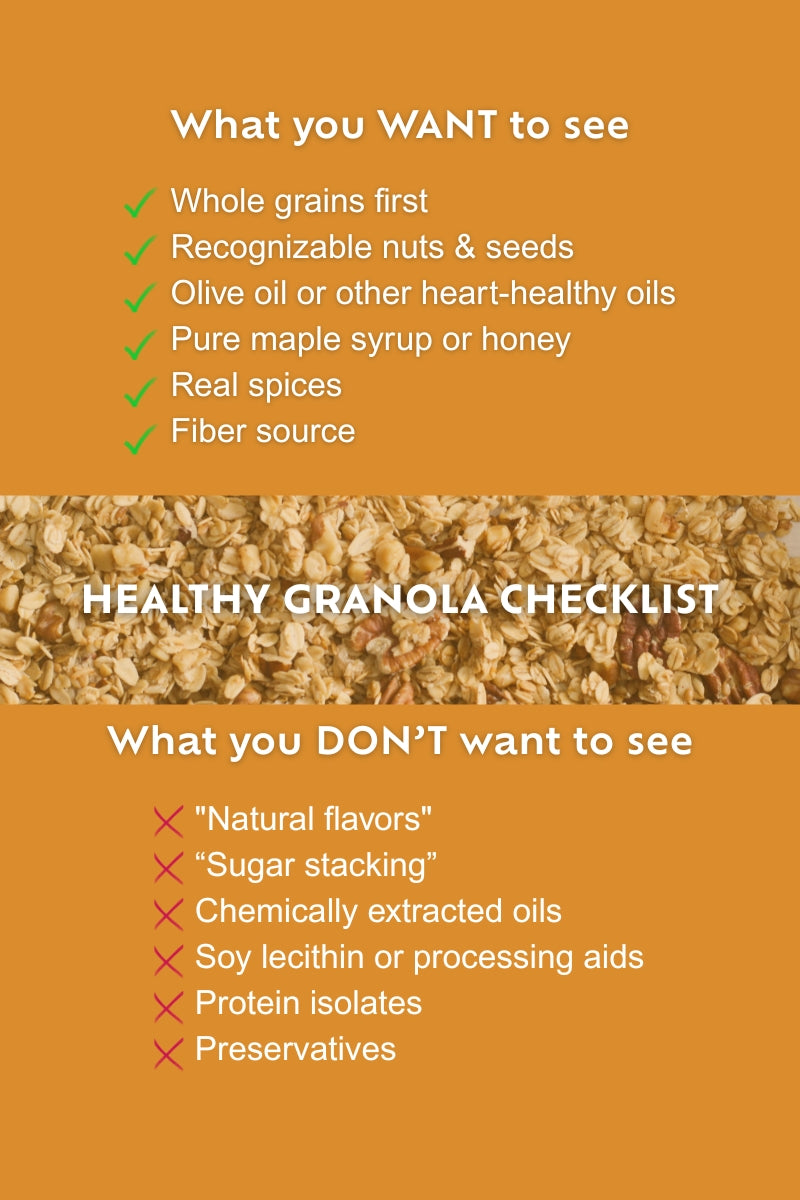
The Healthiest Granola Checklist: Your Shopping Guide
Use this systematic approach every time you're evaluating a new granola brand:
Step 1: Read the Nutrition Facts (Not Just Marketing)
Ignore the front-of-package claims ("All Natural!" "Wholesome!" "Heart Healthy!") and go straight to the Nutrition Facts panel. Use this checklist:
- [ ] Added Sugar: 5g or less (3g or less is exceptional)
- [ ] Sodium: 50mg or less (0mg is ideal for heart health)
- [ ] Protein: 7g or more (for satiety and sustained energy)
- [ ] Fiber: 5g or more (for digestive health and blood sugar control)
- [ ] Serving Size: Check if it's realistic—½ cup is standard for most granolas, though richer varieties (like chocolate) may appropriately use ⅓ cup. Watch for manipulative ¼ cup servings that make nutrition look better than it is.
If a brand fails more than one of these criteria, keep looking.
Step 2: Decode the Ingredient List
Flip to the back and read every ingredient. Here's what you want—and don't want—to see:
What You WANT to See:
- Whole grains first: Rolled oats, quinoa, etc. (not oat flour or processed grain products)
- Recognizable whole nuts and seeds: Almonds, walnuts, pumpkin seeds, flax seeds (not nut powders or isolates)
- Olive oil or other heart-healthy oils: Olive oil is preferable to chemically extracted seed oils (sunflower, canola, soybean) or oils high in saturated fat
- Pure maple syrup or honey used sparingly: These should appear mid-list, not as the second ingredient
- Real spices: Ceylon cinnamon, vanilla powder from real beans, real cocoa
What You DON'T Want to See:
- "Natural flavors": Lab-created compounds, not real ingredients
- "Sugar stacking": Multiple hidden sugars (tapioca syrup + brown rice syrup + barley malt syrup + fruit juice concentrate)
- Chemically extracted oils: Canola, sunflower, soybean—all processed with hexane
- Protein isolates: Lab-created protein powders (pea protein isolate, whey protein isolate) instead of whole nuts/seeds
- Preservatives: BHT, BHA, TBHQ (unnecessary in properly packaged granola)
- Soy lecithin or processing aids: Not necessarily harmful, but indicates more processed production
General Rule: If you can't visualize the ingredient in its whole form, it's probably ultra-processed.
Step 3: Do the Math on Serving Size
This is critical because most brands manipulate serving sizes:
- Most brands use: ¼ cup (30g) servings
- Realistic portion: ½ cup (56-60g) for satisfaction
- The math: Double the serving = double the sugar and sodium
Example:
- Brand A shows "5g sugar per serving"
- Serving size is ¼ cup
- You eat ½ cup (realistic portion) = actually 10g sugar
- Compare that to Brand B: "6g sugar per ½ cup serving"
- Brand B is actually lower sugar when you eat realistic portions
Always convert nutrition facts to ½ cup servings for accurate comparison.
Step 4: Consider Your Personal Health Priorities
Match granola to your specific health goals:
Heart Health Priority:
- Zero sodium + olive oil base (like Brekky Mix varieties)
- Low saturated fat
- High omega-3 fatty acids (from flax, walnuts)
Weight Loss Priority:
- High protein (7-8g) + low sugar (3-5g)
- High fiber for satiety
- Realistic serving sizes that keep you satisfied
Blood Sugar Management:
- Low glycemic impact (high fiber, minimal added sugar)
- No sugar spikes from stacked hidden sugars
- Balanced with protein and healthy fats
Digestive Health:
- High fiber (6-8g)
- Prebiotic ingredients (psyllium husk, inulin)
- Whole food ingredients (easier to digest than ultra-processed)
Energy and Performance:
- Balanced macros (protein + fat + complex carbs)
- Sustained release (not quick sugar spike and crash)
- Whole food nutrients
The Gold Standard: What Premium Granola Delivers
Truly exceptional granola—the kind worth paying premium prices for—should deliver on ALL of these dimensions:
Complete Nutrition Without Compromise:
- All macros balanced (protein, healthy fats, complex carbs)
- Fiber-rich for sustained energy
- Zero sodium for heart health
- Minimal added sugar (≤3g)
Premium Whole Food Ingredients:
- Ceylon cinnamon (not cassia or "natural flavors")
- Real vanilla from beans (not extract with additives)
- Minimally processed olive oil (not chemically extracted seed oils)
- Organic, certified gluten-free oats (no glyphosate)
Honest Serving Sizes:
- Realistic portions that actually satisfy (½ cup minimum)
- No nutritional manipulation through tiny servings
- Transparent about what you're actually eating
Transparent Sourcing:
- Know where ingredients come from
- Understand how they're processed
- Trust the brand's integrity
Small-Batch Quality:
- Woman-owned or family-owned businesses (when possible)
- Craft production that prioritizes quality
For our complete ranking and analysis of the healthiest granola brands on the market, read our Healthiest Granola 2025: In-Depth Analysis of 40+ Brands.
Why Brekky Mix Is Different
The Breakfast Revolution: Granola + Muesli, Evolved
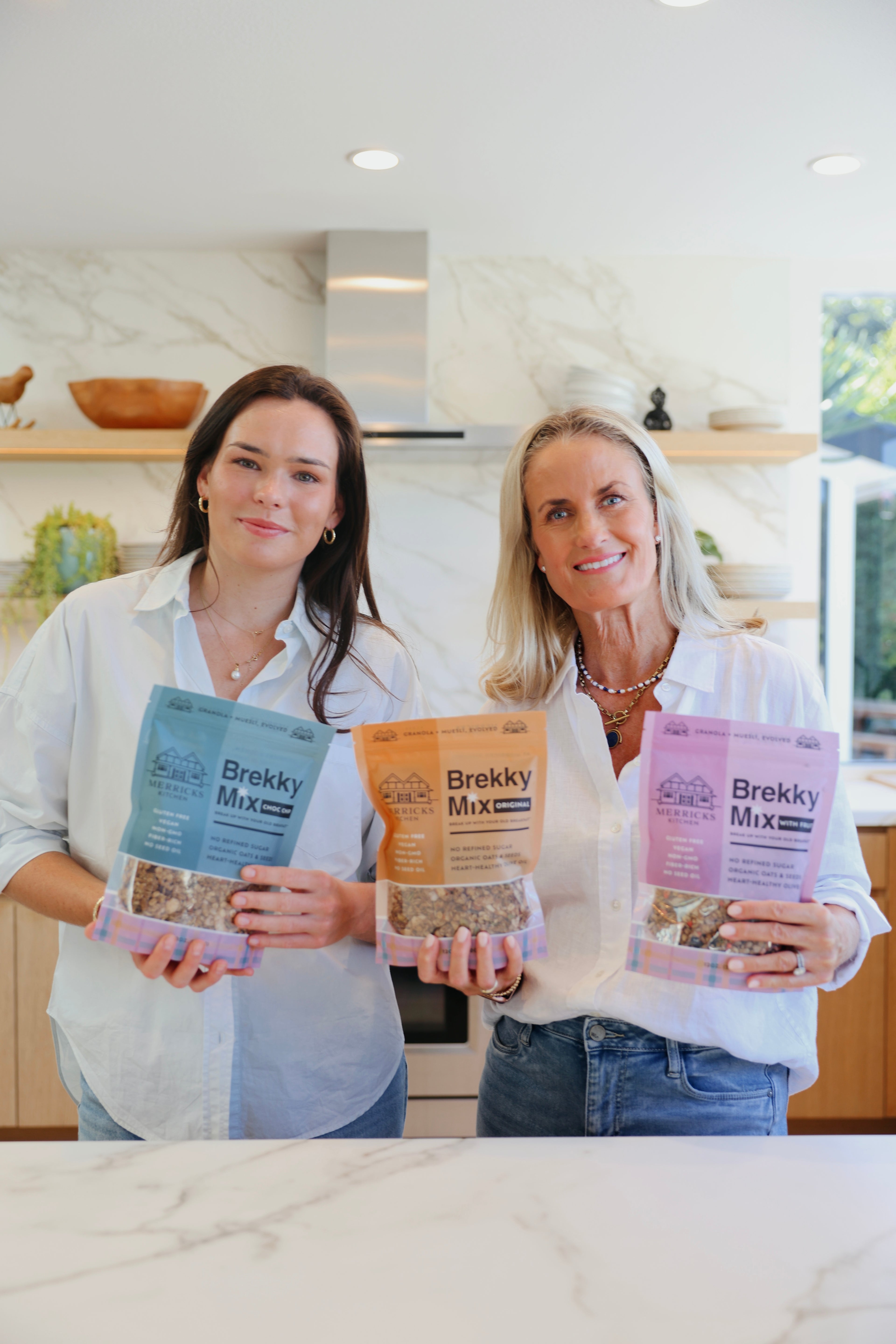
The Problem We Set Out to Solve:
For years, we faced an impossible choice every morning:
- Granola: Tasted amazing but was loaded with sugar (7-12g), high in saturated fat from coconut oil, and full of hidden sodium
- Muesli: Nutritionally excellent, but often tasted like cardboard, with a dry texture and minimal flavor satisfaction
The Gap: Where was the breakfast that's both delicious AND nutritious? Why did we have to choose between health and taste?
This frustration led us to create Brekky Mix—a complete reimagining of breakfast cereal that refuses to compromise on either dimension.
How Brekky Mix Delivers on Every Promise
Zero Sodium Across All Varieties
We're one of only 7 brands (out of 40+ analyzed) that achieves zero sodium across our entire product line. This isn't just a nice-to-have—it's a fundamental commitment to heart health.
- No hidden sodium inflation: Many brands add 50-270mg sodium to enhance flavor and extend shelf life
- Pure, clean taste from real ingredients: When you use premium whole foods, you don't need salt to make them taste good
- Cardiovascular differentiation: Starting your day with 0mg sodium vs. 150-200mg makes a measurable difference in blood pressure management
Minimal Added Sugar (2-3g per serving)
Our sugar content is 67% below the industry average—and we achieve this through premium whole food ingredients, not artificial sweeteners or lab-created flavor enhancers.
- Original: 3g added sugar per ½ cup serving
- With Fruit: 3g added sugar per ½ cup serving
- Choc Chip: 2g added sugar per ⅓ cup serving
Important Note on Serving Sizes: While Choc Chip shows only 2g added sugar, its serving size (⅓ cup) is smaller than Original and Fruit varieties (½ cup) because rich chocolate provides deep satisfaction in a more concentrated portion. The sugar content per ounce is comparable across all varieties. The difference lies in the appropriate portioning for each flavor profile. Choc Chip is often used as a topper for yogurt or fruit rather than eaten in larger bowls, which is why the smaller serving size makes sense.
How We Achieve Low Sugar Without Sacrificing Taste:
- Ceylon cinnamon: Natural sweetness enhancement (not harsh cassia cinnamon or lab-created "natural cinnamon flavor")
- Madagascar vanilla powder: Real vanilla beans ground to powder (not extract with "natural flavors")
- Pure organic maple syrup: Complex natural sweetness used sparingly
- Whole food synergy: Premium ingredients enhance each other, requiring less sugar overall
Minimally Processed Olive Oil Base
We're among a small handful of brands using olive oil—and we believe it's the superior choice for breakfast nutrition.
- Heart-healthy monounsaturated fats: The same fats that make the Mediterranean diet one of the healthiest eating patterns studied
- Natural antioxidants: Polyphenols that provide anti-inflammatory benefits
- No chemical solvent extraction: Unlike seed oils processed with hexane, olive oil is mechanically pressed
- Superior to 85% of competitors: Most brands use coconut oil (high saturated fat) or chemically extracted seed oils
Why don't more brands use olive oil? Cost and consumer unfamiliarity. We chose it anyway because it's the right choice for your health - and it tastes delicious!
High Protein + High Fiber from Whole Foods
Our nutrition comes from real, whole food sources—not lab-created protein isolates or synthetic fiber supplements.
- 6-8g complete protein from gluten-free oats, whole almonds, walnuts, pumpkin seeds, and sunflower seeds (not protein isolates)
- 5-8g dietary fiber for sustained energy and digestive health
- Solves the "10 AM slump": Balanced macros keep you satisfied for 3-4 hours
- Real food nutrition: Your body recognizes and processes whole foods better than isolated nutrients
Honest Serving Sizes That Actually Satisfy
We refuse to play the serving size manipulation game.
- Original & Fruit: ½ cup (56-60g) servings designed to actually satisfy your hunger
- Choc Chip: ⅓ cup (48g) appropriately sized for a rich chocolate experience (often used as a topper)
- No nutritional hiding: Our numbers reflect realistic portions people actually eat
- Transparent comparison: When you compare us to competitors' ¼ cup servings, remember to double their numbers
Premium Whole Food Ingredients (No Lab-Created Shortcuts)
Every ingredient in Brekky Mix serves a purpose and comes from real food sources:
- Ceylon cinnamon: True cinnamon (Cinnamomum verum), not cheaper cassia cinnamon or "natural cinnamon flavor"
- Madagascar vanilla powder: Ground from real vanilla beans, not extract with "natural flavors"
- Organic oats: Made from certified gluten-free oats, never sprayed with glyphosate
- Whole nuts and seeds: Almonds, walnuts, pumpkin seeds, sunflower seeds (not nut powders or protein isolates)
- Pure organic maple syrup: Real maple syrup, not tapioca syrup, brown rice syrup, or other hidden sugars
- No artificial anything: No "natural flavors," no preservatives, no processing aids
- No lab-created ingredients: No protein isolates, no synthetic fibers, no chemical compounds
When you read our ingredient list, you can picture every single ingredient in its whole form. That's the Brekky Mix difference.
Three Flavors, Zero Compromises
Brekky Mix Original: The Balanced Classic
Our foundation flavor that started it all. Clean, balanced nutrition with the perfect blend of:
- 8g protein, 6g fiber, 3g added sugar, 0mg sodium
- Hearty oats, crunchy nuts, and seeds with Ceylon cinnamon warmth
- The breakfast that loves you back
Brekky Mix with Fruit: Bright, Naturally Sweet, Energizing
All the nutrition of Original plus antioxidant-rich dried fruit:
- 8g protein, 6g fiber, 3g added sugar, 0mg sodium
- Real dates, strawberries, and blueberries (not "natural fruit flavor")
- Natural sweetness without sugar spikes
Brekky Mix Choc Chip: Indulgence Meets Nourishment
Revolutionary chocolate granola with only 2g added sugar per serving:
- 6g protein, 5g fiber, 2g added sugar (per ⅓ cup), 0mg sodium
- Fair-trade dark chocolate chips
- Proof that a chocolate breakfast can be healthy
Easy Healthy Breakfast Ideas Using Granola
How You Eat Granola Changes Its Nutritional Impact
Before we dive into recipes, it's important to understand that how you eat granola significantly affects your overall nutrition—both in terms of portion control and the complete nutritional profile of your meal.
Granola as Cereal (with Milk):
- Typical serving: ½ to 1 cup granola
- Nutritional benefit: You'll get the complete nutrition from the granola itself, plus calcium, vitamin D, and protein from milk (dairy or fortified plant-based)
- Portion awareness: It's easy to pour more than ½ cup when eating granola like cereal, which means you could be consuming double the sugar and calories listed on the label
- Best practice: Measure your portion into a bowl first, then add milk
Granola as a Topper (Yogurt Bowls, Fruit Bowls):
- Typical serving: ¼ to ⅓ cup granola
- Nutritional benefit: You're eating less granola (fewer calories and less sugar) while getting fiber and antioxidants from fruit, plus probiotics, protein, and calcium from yogurt
- The advantage: This combination creates a more balanced meal—the yogurt and fruit provide bulk and satiety, while granola adds satisfying crunch and flavor
- Best for: Weight management, blood sugar control, digestive health
Granola Straight from the Bag:
- Risk: Without measuring, it's incredibly easy to eat 1-2 cups (or more) in a sitting
- Reality check: That "healthy snack" could deliver 500+ calories and 6-12g sugar before you realize it
- Better approach: Pre-portion granola into ¼ or ½ cup servings in small containers or bags for true grab-and-go convenience with built-in portion control
The Bottom Line: The healthiest way to enjoy granola is as a topper or mix-in rather than the main event. This naturally controls portions while letting you build a more nutritionally complete meal with complementary ingredients.
Beyond the Bowl: Creative Ways to Enjoy Healthy Granola
Once you have truly healthy granola, the possibilities expand far beyond the basic bowl with milk. Here are quick, nutritious ways to incorporate Brekky Mix into your morning routine:
1. The Classic Yogurt Bowl
- ½ cup Greek yogurt (high protein)
- ⅓-½ cup Brekky Mix
- Fresh berries
- Drizzle of honey (optional)
Nutrition benefit: Combines probiotics from yogurt with prebiotics from granola fiber, plus sustained energy from protein and healthy fats.
2. Smoothie Bowl Topper
- Make your favorite smoothie base
- Pour into bowl
- Top with Brekky Mix for crunch and whole fruit pieces for texture and complete nutrition
Why this works: Smoothies alone often lack staying power. Adding granola provides texture, slows consumption (better satiety signals), and adds protein/fiber that keeps you full longer.
3. Overnight Oats Upgrade
- ½ cup rolled oats
- ½ cup milk of choice
- 2 tablespoons chia seeds
- ¼ cup Brekky Mix mixed in
- Top with another ¼ cup before eating
Meal prep advantage: Make 5 jars on Sunday, grab one each morning. The granola on top stays crunchy while the portion mixed in softens slightly for texture variety.
4. Energy Bites / Breakfast Balls
- 1 cup Brekky Mix
- ½ cup nut butter
- ¼ cup honey or maple syrup
- Mix and roll into balls
- Refrigerate
Perfect for: Busy mornings, on-the-go breakfast, pre-workout fuel, traveling
5. Breakfast Parfait (Meal Prep Champion)
- Make this one just before eating to avoid sogginess
- Layer in mason jars: yogurt, Brekky Mix, fruit, repeat
- Enjoy!
Pro tip: Keep granola layer thin to avoid sogginess, or add just before eating.
6. Apple or Banana "Nachos"
- Slice apple or banana (or any other fruit you love)
- Top with a drizzle of nut butter
- Sprinkle Brekky Mix on top
- Optional: squeeze of dark chocolate or honey
Kid-friendly: Makes healthy eating fun and interactive
7. Cottage Cheese Power Bowl
- 1 cup whipped cottage cheese (high protein)
- ½ cup Brekky Mix
- Fresh fruit
- Cinnamon sprinkle
Protein powerhouse: 30+ grams of protein to start your day
8. Acai or Pitaya Bowl Base
- Frozen acai or pitaya blended with banana
- Top with Brekky Mix, fresh fruit, coconut
- Instagram-worthy and nutritious
For more inspiration and complete recipes with nutritional breakdowns, explore our Ultimate Guide to Healthy Breakfast Ideas.
Meal Prep Tips for Busy Mornings
Make Breakfast Effortless:
- Portion control: Divide Brekky Mix into ½ cup portions in small containers or bags for grab-and-go convenience
- Yogurt parfaits: Prep 5 mason jar parfaits on Sunday for the entire work week
- Desk drawer stash: Keep a bag of Brekky Mix at work for days you rush out without breakfast
- Travel-friendly: Pack in TSA-friendly portions for healthy hotel breakfast (much better than continental breakfast offerings)
- Pre-mixed bowls: Combine your favorite add-ins (nuts, seeds, dried fruit) with Brekky Mix in advance
Storage Tips:
- Keep opened bags in airtight container to maintain freshness
- Store in cool, dry place (not refrigerator—can cause moisture condensation)
- Properly stored, your opened bag of Brekky Mix should stay fresh for 3-6 months
The Verdict on "Is Granola Healthy?"
The Final Answer
Is granola healthy? Yes—but ONLY if you choose wisely.
After analyzing 40+ brands and examining thousands of ingredient lists and nutrition labels, here's the uncomfortable truth: Most grocery store granola is glorified dessert masquerading as health food.
But truly healthy granola—with minimal added sugar (≤3g), zero sodium, minimally processed olive oil, honest serving sizes, and whole food ingredients—can be one of the most nutritious and satisfying breakfast choices available.
The key is knowing what to look for and refusing to compromise.
What We've Learned
The Three Pillars of Healthy Granola:
- Sugar Standards: Aim for 3g or less added sugar. Anything over 5g starts compromising blood sugar management. Watch for "sugar stacking" where brands hide total sugar across multiple ingredients.
- Sodium Reality: Zero sodium is ideal for heart health. Only 7 brands out of 40+ achieve this standard. There's simply no reason for sodium in granola except to mask inferior ingredients.
- Ingredient Quality: Whole foods beat lab-created ingredients every time. Real Ceylon cinnamon beats "natural cinnamon flavor." Whole nuts beat protein isolates. Minimally processed olive oil beats chemically extracted seed oils.
The Red Flags to Avoid:
- "Natural flavors" (lab-created compounds)
- Protein isolates instead of whole nuts/seeds
- Chemically extracted seed oils (canola, sunflower, soybean)
- Serving size manipulation (¼ cup servings)
- Sugar stacking (multiple hidden sugars)
- High sodium (over 100mg is questionable)
The Green Flags to Seek:
- Certified gluten-free oats (organic is even better)
- Olive oil as the fat source
- Complete ingredient transparency
- Honest serving sizes (½ cup minimum)
- Minimal added sugar from quality sources
- Woman-owned or small-batch production (often indicates higher quality standards)
Your Action Plan
Step 1: Clean Out Your Pantry
- Check your current granola against the standards in this guide
- If it fails on multiple dimensions, it's time to upgrade
- Don't fall for marketing claims—read the actual nutrition facts and ingredients
Step 2: Apply the Checklist
- Use our shopping guide when evaluating new brands
- Don't compromise—demand products that check all the boxes
- Remember that price per ounce isn't the same as value per serving
Step 3: Do the Serving Size Math
- Always convert nutrition facts to ½ cup servings for accurate comparison
- Brands using ¼ cup servings need their numbers doubled
- Be honest with yourself about how much you actually eat
Step 4: Prioritize Whole Food Ingredients
- Real ingredients should be recognizable in their whole form
- If you can't picture the ingredient, it's probably ultra-processed
- "Natural flavors" = red flag, real vanilla powder = green flag
Step 5: Give Your Palate Time to Adjust
- If you're coming from high-sugar granola, give yourself 2-3 weeks to adjust
- Your taste buds will reset and high-sugar options will start tasting too sweet
- Focus on the sustained energy and satisfaction, not just immediate sweetness
Ready to Break Up With Your Old Breakfast?
If you're tired of compromising between taste and nutrition, if you're exhausted by granola brands that claim to be healthy while hiding sugar, sodium, and chemically extracted oils, Brekky Mix was created specifically for you.
We've spent years perfecting the formula that delivers on every promise:
- 0mg sodium across all varieties (heart health without compromise)
- 2-3g added sugar (67% below industry average, achieved through premium ingredients)
- Heart-healthy olive oil (minimally processed, Mediterranean diet benefits)
- Whole food ingredients only (no "natural flavors," protein isolates, or lab-created shortcuts)
- Honest serving sizes (realistic portions that actually satisfy)
- Organic oats made from certified gluten-free oats (no glyphosate, no cross-contamination)
Three Flavors to Explore:
Brekky Mix Original - The balanced classic that started it all. Perfect for purists who want complete nutrition without compromise.
Brekky Mix with Fruit - Bright, naturally sweet, energizing. All the nutrition of Original plus antioxidant-rich dried fruit.
Brekky Mix Choc Chip - Indulgence meets nourishment. Revolutionary chocolate granola with only 2g added sugar per serving.
Not Sure Which Flavor to Try First?
Our Brekky Mix Trio includes all three varieties so you can discover your favorite while saving on your first order. It's the perfect way to break up with your old breakfast and start a healthier relationship with your morning bowl.
The Bottom Line
Granola can absolutely be a healthy breakfast choice—but only if you demand more from the brands you buy. Don't settle for "better than a donut" when you can have complete nutrition that actually tastes incredible.
Your breakfast sets the tone for your entire day. Make it count.
Ready to make the switch? Explore Brekky Mix varieties and taste what happens when you refuse to compromise on nutrition or flavor.
Related Reading:
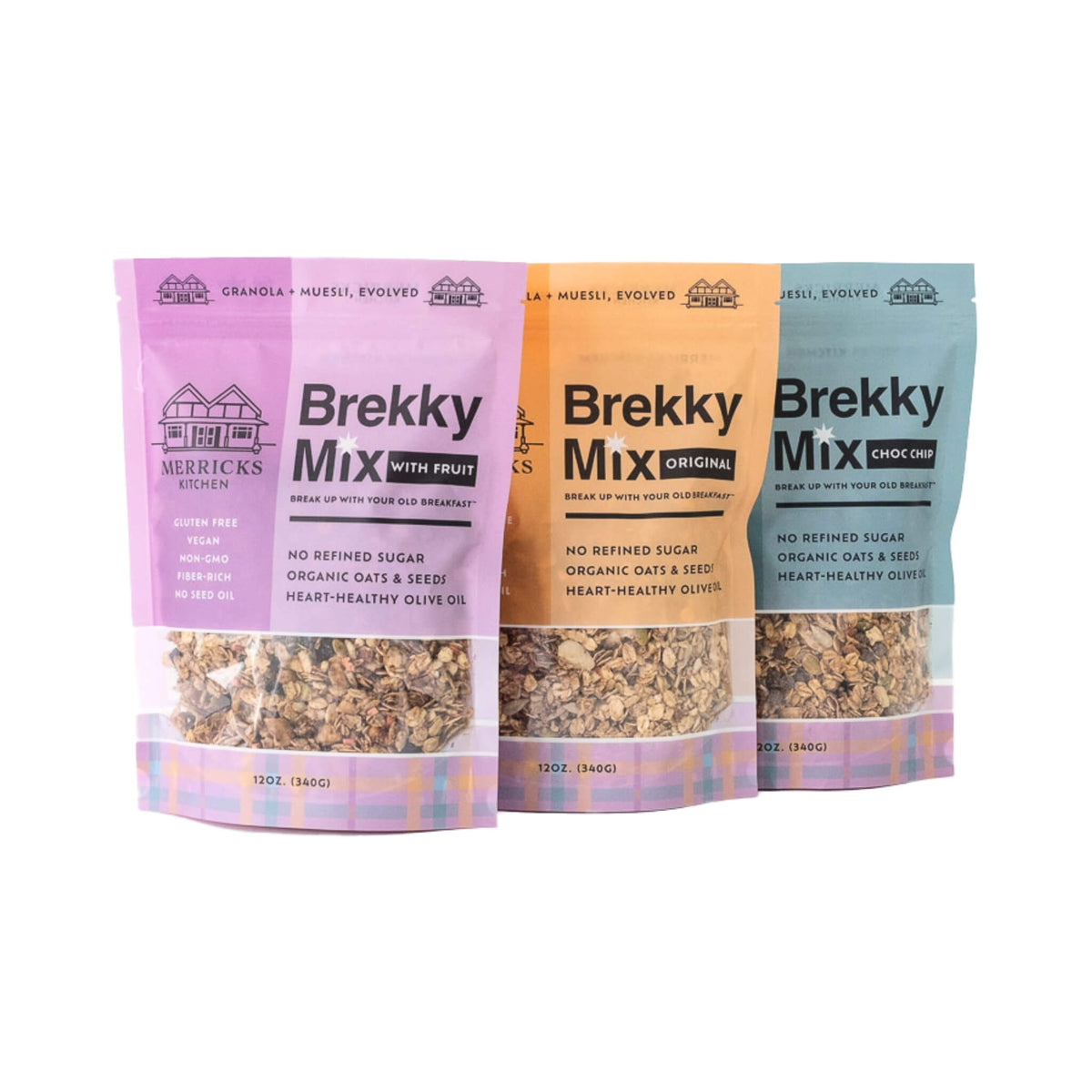

0 comments